Water, Energy and Food Nexus in Rice Production in Thailand
Abstract
:1. Introduction
2. Materials and Methods
2.1. Study Area and Background Data
2.2. Water and Energy Flow in the Base Case
2.2.1. Energy Sub-system Flow
2.2.2. Water Sub-System Flow
2.3. Nexus Model
2.4. Resource Security Indicator
2.5. Scenario Analysis
3. Results and Discussion
3.1. Water and Energy Flow System
3.2. WEF Nexus in the Scenarios
3.3. Resource Security and Economic Analysis
4. Conclusions
Author Contributions
Funding
Conflicts of Interest
References
- Hoff, H. Understanding the Nexus. In Proceedings of the The Water, Energy and Food Security Nexus; Springer: Bonn, Germany, 2011. [Google Scholar]
- FAO. Walking the Nexus Talk: Assessing the Water-Energy-Food Nexus in the Context of the Sustainable Energy for All Initiative; FAO: Rome, Italy, 2014. [Google Scholar]
- FAO. The Water-Energy-Food Nexus. A New Approach in Support of Food Security and Sustainable Agriculture; FAO: Rome, Italy, 2014. [Google Scholar]
- Issawilanont, S. Production Marketing and Creating Rice Networks. In Roi Khaen Kalasin Provincial Cluster Seminar; Khonkhan Provincial Office: Khonkhan, Thailand, 2015. [Google Scholar]
- Issawilanont, S. Rice research to Thailand 4.0; Agricultural Research Development Agency in collaboration with the rice partner organizations4: Bangkok, Thailand, 2018. [Google Scholar]
- Lamjiak, R. Vietnam rice policy: the Main Trade Rival of Thailand; The Secretariat of the Senate: Bangkok, Thailand, 2014. Available online: http://library.senate.go.th/document/Ext7661/7661093_0002.PDF (accessed on 5 October 2019).
- Boonyaprapas, C. Sustainable Thai Rice Development; Prachachart: Bangkok, Thailand, 2017. [Google Scholar]
- Puapongsakorn, N.; Thitapiwatanakul, B.; Tohkritsana, R.; Sirisupalak, P.; Nititanprapas, I.; Napasinthuwong, O.; Supanchad, W.; Sanglertsawai, S.; Udomsopakit, S.; Lathapipat, D. Thai Rice Strategy Project; Thai Rice Research Development and Forward-Looking Thailand Policy Monitoring Project; Thailand Research Fund(TRF). 2013. Available online: http://www.agripolicyresearch.com/wp-content/plugins/download-attachments/includes/download.php?id=3537 (accessed on 5 October 2019).
- TREA. Rice Export Quantity and Value: 2016; Thailand Rice Exporters Association: Bangkok, Thailand, 2018. [Google Scholar]
- RID. Water Management and Crop Plantation Plan of 2016 Wet and Dry Season; Royal Irrigation Department; Ministry of Agriculture: Bangkok, Thailand, 2016. [Google Scholar]
- Gheewala, S.; Silalertruksa, T.; Nilsalab, P.; Lecksiwilai, N.; Sawaengsak, W.; Mungkung, R.; Ganasut, J. Water stress index and its implication for agricultural land-use policy in Thailand. Int. J. Environ. Sci. Technol. 2017, 15, 833–846. [Google Scholar] [CrossRef]
- HAII. Data Collecting and Analyzing, 25 Basin Database Warehouse and Flood-Drought Model Development Projects: Chaopraya Basin; Hydro and Agro Informatics Institute: Bangkok, Thailand, 2012. [Google Scholar]
- Hoekstra, A.Y.; Hung, P.Q. Globalisation of water resources: International virtual water flows in relation to crop trade. Glob. Environ. Chang. 2005, 15, 45–56. [Google Scholar] [CrossRef]
- Ministry of Agriculture. Executive Summary of Main Agricultural Policy and Progress of Implementation; Ministry of Agriculture: Bangkok, Thailand, 2018. (In Thailand)
- Baccini, P.; Brunner, P.H. Metabolism of the Anthroposphere; Springer: Heidelberg/Berlin, Germany; New York, NY, USA, 1991; New edition March. MIT Press: Cambridge, MA, USA, 2012. [Google Scholar]
- Brunner Paul, H.; Rechberger, H. Anthropogenic Metabolism and Environmental Legacies Archived December 17, 2008, at the Wayback Machine in Encyclopedia of Global Environmental Change; Wiley: New York, NY, USA, 2002; ISBN 0-471-97796-9. [Google Scholar]
- Obernosterer, R.; Brunner, P.H.; Daxbeck, H.; Gagan, T.; Glenck, E.; Hendriks, C.; Morf, L.; Paumann, R.; Reiner, I. IUrban Metabolism: The City of Vienna, Case Study Report 1. In Materials Accounting as a Tool for Decision making in Environmental Policy (MacTEmPo); Final Report EC Program Environment and Climate 1994–1998; Institute for Water Quality and Waste Management, Vienna University: Vienna, Austria, 1998; ENV4–CT96–0230; Available online: http://publik.tuwien.ac.at/files/PubDat_143905.pdf (accessed on 15 September 2019).
- Hendriks, R.; Obernosterer, D.; Müller, S.; Kytzia, P.; Baccini, P.H. Brunner, Carolyn Material Flow Analysis: A tool to support environmental policy decision making. Case-studies on the city of Vienna and the Swiss lowlands. Local Environ. 2000, 5, 311. [Google Scholar] [CrossRef]
- Lennox, A.J.; Turner, G. State of the Environment Report: Report on Human Settlements, Stocks and Flows Indicators; Department of the Environment and Heritage: Canberra, Australia, 2005. [Google Scholar]
- Jakrawatana, N.; Ngammuangtueng, P.; Gheewala, S.H. Linking substance flow analysis and soil and water assessment tool for nutrient management. J. Clean. Prod. 2017, 142, 1158–1168. [Google Scholar] [CrossRef]
- Pingmuanglek, P.; Jakrawatana, N.; Gheewala, S.H. Freshwater use analysis of cassava for food feed fuel in the Mun River basin, Thailand. Int. J. Life Cycle Assess. 2017, 22, 1705–1717. [Google Scholar] [CrossRef]
- Lofman, D.; Petersen, M.; Bower, A. Water, Energy and Environment Nexus: The California Experience. Int. J. Water Resour. Dev. 2002, 18, 73–85. [Google Scholar] [CrossRef]
- United Nations ESCAP. The Status of the Water-Food-Energy Nexus in Asia and the Pacific; United Nations publication: New York, NY, USA, 2013. [Google Scholar]
- GIZ. The Water-Energy-Food Security Nexus: A Review of Nexus Literature and Ongoing Nexus Initiatives for Policymakers; Nexus Regional Dialogue Programme (NRD): Bonn, Germany, 2018. [Google Scholar]
- Newell, J.; Goldstein, B.; Foster, A. A 40-year review of food–energy-water nexus literature and its application to the urban scale. Environ. Res. Lett. 2019, 14, 073003. [Google Scholar] [CrossRef]
- Albrecht, T.R.; Arica Crootof, A.; Scott, C.A. The Water-Energy-Food Nexus: A systematic review of methods for nexus assessment. Environ. Res. Lett. 2018, 13, 043002. [Google Scholar] [CrossRef]
- Daher, B.T.; Mohtar, R.H. Water–Energy–Food (WEF) Nexus Tool 2.0: Guiding Integrative Resource Planning and Decision-Making. Water Int. 2015, 8060, 1–24. [Google Scholar] [CrossRef]
- Owen, A.; Scott, K.; Barrett, J. Identifying critical supply chains and final products: An input-output approach to exploring the energy-water-food nexus. Appl. Energy 2018, 210, 632–642. [Google Scholar] [CrossRef]
- Salmoral, G.; Yan, X. Food-energy-water nexus: A life cycle analysis on virtual water and embodied energy in food consumption in the Tamar catchment, UK. Resour. Conserv. Recycl. 2018, 133, 320–330. [Google Scholar] [CrossRef]
- Al-Ansari, T.; Korre, A.; Nie, Z.; Shah, N. Development of a life cycle assessment tool for the assessment of food production systems within the energy, water and food nexus Sustain. Prod. Consum. 2015, 2, 52–66. [Google Scholar] [CrossRef]
- De Laurentiis, V.; Hunt, D.V.L.; Rogers, C.D.F. Overcoming food security challenges within an energy/water/food nexus (EWFN) approach. Sustainability 2016, 8, 95. [Google Scholar] [CrossRef]
- Irabien, A.; Darton, R.C. Energy–water–food nexus in the Spanish greenhouse tomato production. Clean. Technol. Environ. Policy 2015, 18, 1307–1316. [Google Scholar] [CrossRef]
- Cottee, J.; Lopez-Aviles, A.; Behzadian, K.; Bradley, D.; Butler, D.; Downing, C.; Farmani, R.; Ingram, J.; Leach, M.; Pike, A.; et al. The Local Nexus Network: Exploring the Future of Localised Food Systems and Associated Energy and Water Supply Sustainable Design and Manufacturing 2016. In Smart Innovation, Systems and Technologies; Springer: Cham, Switzerland, 2016; Volume 52, pp. 613–624. ISBN 978-3-319-32096-0. [Google Scholar]
- Daccache, A.; Ciurana, J.S.; Rodriguez Diaz, J.A.; Knox, J.W. Water and energy footprint of irrigated agriculture in the Mediterranean region. Environ. Res. Lett. 2014, 9, 124014. [Google Scholar] [CrossRef]
- Damerau, K.; Patt, A.G.; van Vliet, O.P.R. Water saving potentials and possible trade-offs for future food and energy supply. Glob. Environ. Chang 2016, 39, 15–25. [Google Scholar] [CrossRef] [Green Version]
- Wicaksono, A.; Kang, D. Nationwide simulation of water. Energy, and food nexus:case study in South Korea and Indonesia. J. Hydro-Environ. Res. 2019, 2, 70–87. [Google Scholar] [CrossRef]
- Lee, S.-H.; Taniguchi, M.; Mohtar, R.; Choi, J.-Y.; Yoo, S.-H. An Analysis of the Water-Energy-Food-Land Requirements and CO2 Emissions for Food Security of Rice in Japan. Sustainability 2018, 10, 3354. [Google Scholar] [CrossRef]
- Hu, M.-C.; Fan, C.; Huang, T.; Wang, C.-F.; Chen, Y.-H. Urban Metabolic Analysis of a Food-Water-Energy System for Sustainable Resources Management. Int. J. Environ. Res. Public Health 2018, 16, 90. [Google Scholar] [CrossRef]
- Perrone, D.; Murphy, J.; Hornberger, G.M. Gaining Perspective on the Water−Energy Nexus at the Community Scale. Environ. Sci. Technol. 2011, 45, 4228–4234. [Google Scholar] [CrossRef]
- Lin, J.; Kang, J.; Bai, X.; Li, H.; Lv, X.; Kou, L. Modeling the urban water-energy nexus: A case study of Xiamen, China. J. Clean. Prod. 2019, 215, 680–688. [Google Scholar] [CrossRef]
- Howells, M.; Hermann, S.; Welsch, M.; Bazilian, M.; Engström, R.; Alfstad, T.; Gielen, D.; Rogner, H.; Fischer, G.; Velthuizen, H.; et al. Integrated Analysis of Climate Change, Land-Use, Energy and Water Strategies. Nat. Clim. Chang. 2013, 3, 621. [Google Scholar] [CrossRef]
- Giampietro, M.; Aspinall, R.; Bukkens, S.; Cadillo, J.; Diaz-Maurin, F.; Flammini, A.; Gomiero, T.; Kovacic, Z.; Madrid Lopez, C.; Ramos-Martin, J.; et al. An Innovative Accounting Framework for the Food-Energy-Water Nexus: Application of the Musiasem Approach to Three Case Studies; FAO: Rome, Italy, 2013; ISBN 978-92-5-107957-7. [Google Scholar]
- Villarroel Walker, R.; Beck, M.B.; Hall, J.W.; Dawson, R.J.; Heidrich, O. The energy-water-food nexus: Strategic analysis of technologies for transforming the urban metabolism. J. Environ. Manag. 2014, 141, 104–115. [Google Scholar] [CrossRef] [PubMed]
- Mukuve, F.M.; Fenner, R.A. Scale variability of water, land, and energy resource interactions and their influence on the food system in Uganda. Sustain. Prod. Consum. 2015, 2, 79–95. [Google Scholar] [CrossRef]
- Bazilian, M.; Rogner, H.; Howells, M.; Hermann, S.; Arent, D.; Gielen, D.; Steduto, P.; Mueller, A.; Komor, P.; Tol, R.S.J.; et al. Considering the energy, water and food nexus: Towards an integrated modeling approach. Energy Policy 2011, 39, 7896–7906. [Google Scholar] [CrossRef]
- Miara, A.; Pienkos, P.T.; Bazilian, M.; Davis, R.; Macknick, J. Planning for algal systems: An energy-water-food nexus perspective. Ind. Biotechnol. 2014, 10, 202–211. [Google Scholar] [CrossRef]
- OAE. Agricultural Statistics of Thailand 2016. Office of Agriculture and Economics, Ministry of Agriculture and Cooperatives, Bangkok. Available online: http://www.oae.go.th/assets/portals/1/files/ebook/yearbook59.pdf (accessed on 20 June 2019).
- OAE. Agricultural Statistics of Thailand 2009. Office of Agriculture and Economics, Ministry of Agriculture and Cooperatives, Bangkok. Available online: http://www.oae.go.th/assets/portals/1/files/ebook/yearbook52.pdf (accessed on 20 June 2019).
- OAE. Agricultural Statistics of Thailand 2010. Office of Agriculture and Economics, Ministry of Agriculture and Cooperatives, Bangkok. Available online: http://www.oae.go.th/assets/portals/1/files/ebook/yearbook53.pdf (accessed on 20 June 2019).
- OAE. Agricultural Statistics of Thailand 2011. Office of Agriculture and Economics, Ministry of Agriculture and Cooperatives, Bangkok. Available online: http://www.oae.go.th/assets/portals/1/files/ebook/yearbook54.pdf (accessed on 20 June 2019).
- OAE. Agricultural Statistics of Thailand 2012. Office of Agriculture and Economics, Ministry of Agriculture and Cooperatives, Bangkok. Available online: http://www.oae.go.th/assets/portals/1/files/ebook/yearbook55.pdf (accessed on 20 June 2019).
- OAE. Agricultural Statistics of Thailand 2013. Office of Agriculture and Economics, Ministry of Agriculture and Cooperatives, Bangkok. Available online: http://www.oae.go.th/assets/portals/1/files/ebook/yearbook56.pdf (accessed on 20 June 2019).
- OAE. Agricultural Statistics of Thailand 2014. Office of Agriculture and Economics, Ministry of Agriculture and Cooperatives, Bangkok. Available online: http://www.oae.go.th/assets/portals/1/files/ebook/yearbook57.pdf (accessed on 20 June 2019).
- OAE. Agricultural Statistics of Thailand 2015. Office of Agriculture and Economics, Ministry of Agriculture and Cooperatives, Bangkok. Available online: http://www.oae.go.th/assets/portals/1/files/ebook/yearbook58.pdf (accessed on 20 June 2019).
- OAE. Agricultural Statistics of Thailand 2017. Office of Agriculture and Economics, Ministry of Agriculture and Cooperatives, Bangkok. Available online: http://www.oae.go.th/assets/portals/1/files/ebook/yearbook60.pdf (accessed on 20 June 2019).
- OAE. Agricultural Statistics of Thailand 2018. Office of Agriculture and Economics, Ministry of Agriculture and Cooperatives, Bangkok. Available online: http://www.oae.go.th/assets/portals/1/files/jounal/2562/yearbook2561.pdf (accessed on 20 June 2019).
- RID. Alternate Wet and Dry (AWD) System for Paddy Rice Cultivation; Royal Irrigation Department, Ministry of Agriculture: Bangkok, Thailand, 2015.
- Bhumiratana, S. Bioeconomy in the context of Thailand. In Proceedings of the Thai-German Bioeconomy Conference: Cooperation Opportunities for a Sustainable Bioeconomy, Chiang Mai, Thailand, 28–29 January 2016. [Google Scholar]
- Tanticharoen, M. Bioeconomy in the Context of Thailand; GBS: Berlin, Germany, 2018. [Google Scholar]
- Thailand Board of Investment. Thailand’s Bioeconomy Industry; Thailand Board of Investment: Bangkok, Thailand, 2017. [Google Scholar]
- Maneepitak, S.; Ullah, H.; Paothong, K.; Kachenchart, B.; Datta, A.; Shrestha, R.P. Effect of water and rice straw management practices on yield and water productivity of irrigated lowland rice in the Central Plain of Thailand. Agric. Water Manag. 2019, 211, 89–97. [Google Scholar] [CrossRef]
- Stuart, A.M.; Pame, A.R.P.; Vithoonjit, D.; Viriyangkura, L.; Pithuncharurnlap, J.; Meesang, N.; Suksiri, P.; Singleton, G.R.; Lampayan, R.M. The application of best management practices increases the profitability and sustainability of rice farming in the central plains of Thailand. Field Crop. Res. 2018, 220, 78–87. [Google Scholar] [CrossRef]
- Carrijo, D.R.; Lundy, M.E.; Linquist, B.A. Rice yields and water use under alternate wetting and drying irrigation: A meta-analysis. Field Crop. Res. 2017, 203, 173–180. [Google Scholar] [CrossRef]
- LaHue, G.T.; Chaney, R.L.; Adviento-Borbe, M.A.; Linquist, B.A. Alternate wetting and drying in high yielding direct-seeded rice systems accomplishes multiple environmental and agronomic objectives. Agric. Ecosyst. Environ. 2016, 229, 30–39. [Google Scholar] [CrossRef]
- Rejesus, R.M.; Palis, F.G.; Rodriguez, D.G.P.; Lampayan, R.M.; Bouman, B.A.M. Impact of the alternate wetting and drying (AWD) water-saving irrigation technique: Evidence from rice producers in the Philippines. Food Policy 2011, 36, 280–288. [Google Scholar] [CrossRef]
- Maneewan, N. Determination of Suitable Area for Economic Crops. In Proceedings of the the 4th National Seminar on Soil and Fertilizer, Bangkok, Thailand, 4–8 July 2015. [Google Scholar]
- Gheewala, S.H.; Silalertruksa, T.; Prasara, A.J.; Prapaspongsa, T.; Jakrawatana, N.; Pongpat, P.; Sawaengsak, W.; Permpool, N.; Chatwachirawong, P.; Leal, M.R.L.V. Sustainability assessment of sugarcane complex for enhancing the competitiveness of Thai sugarcane industry. In The Joint Graduate School Energy and Environment; King Mongkut’s University of Technology: Thonburi, Thailand, 2016. [Google Scholar]
- Pingmuanglek, P. An Analysis of Alternatives for Sustainable Management of Cassava and Its Related Products for the Future Sustainability of Food and Biofuels; University of Phayao: Phayao, Thailand, 2016. [Google Scholar]
- Jakrawatana, N. Material Flow Cost Accounting of Maize Supply Chain in Thailand for Improving Eco-Efficiency. Asian J. Account. Gov. 2016, 8, 107–121. [Google Scholar]
- Hanafiah, M.; Ghazali, N.; Harun, N.; Abdulaali, S.; Abdulhasan, M.; Khairul, M.; Kamarudin, M. khairul amri Desalination; Water Treatment. Assessing water scarcity in Malaysia: A case study of rice production. Desalin. WATER Treat. 2019, 149, 274–287. [Google Scholar] [CrossRef]

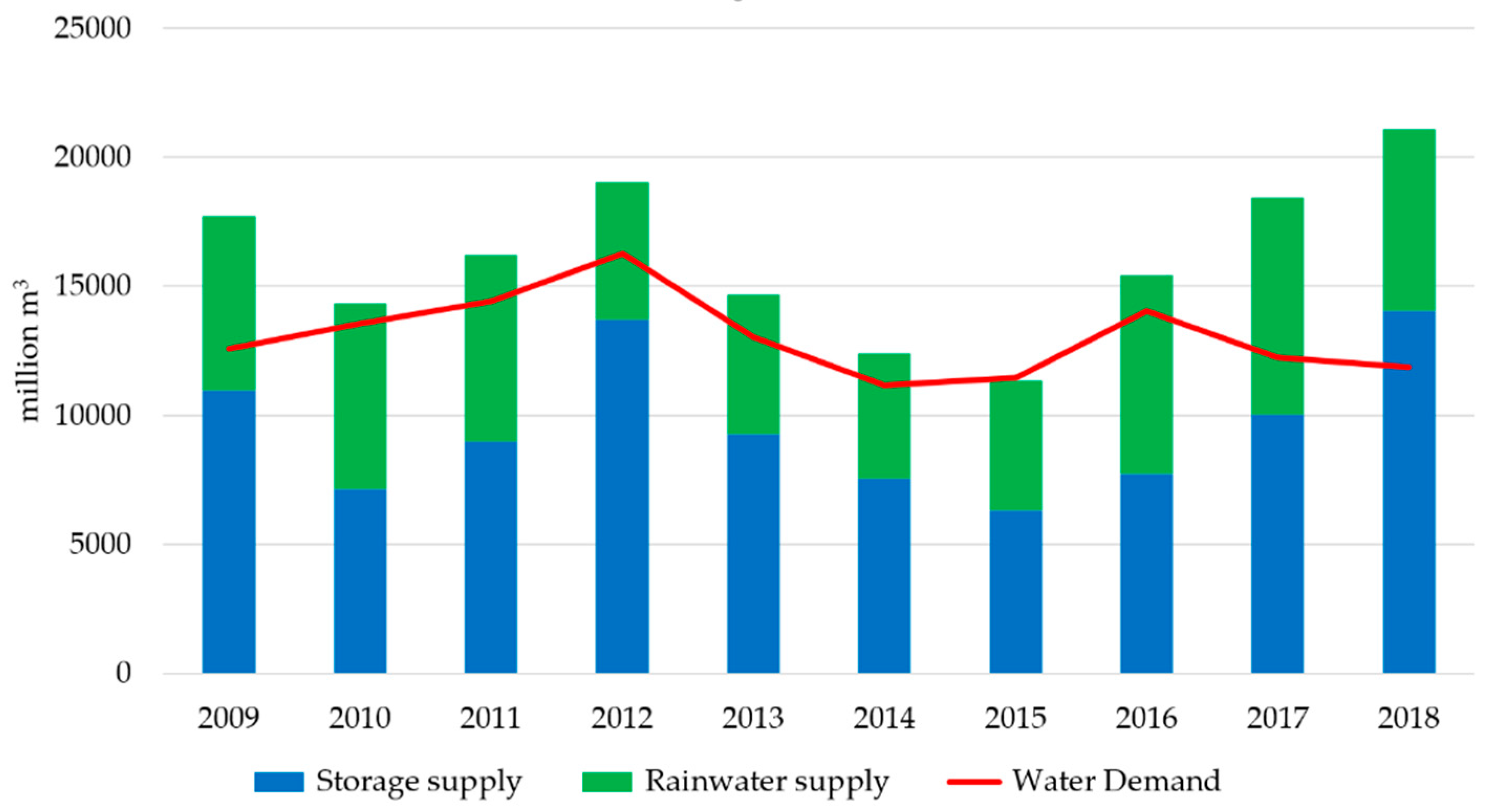

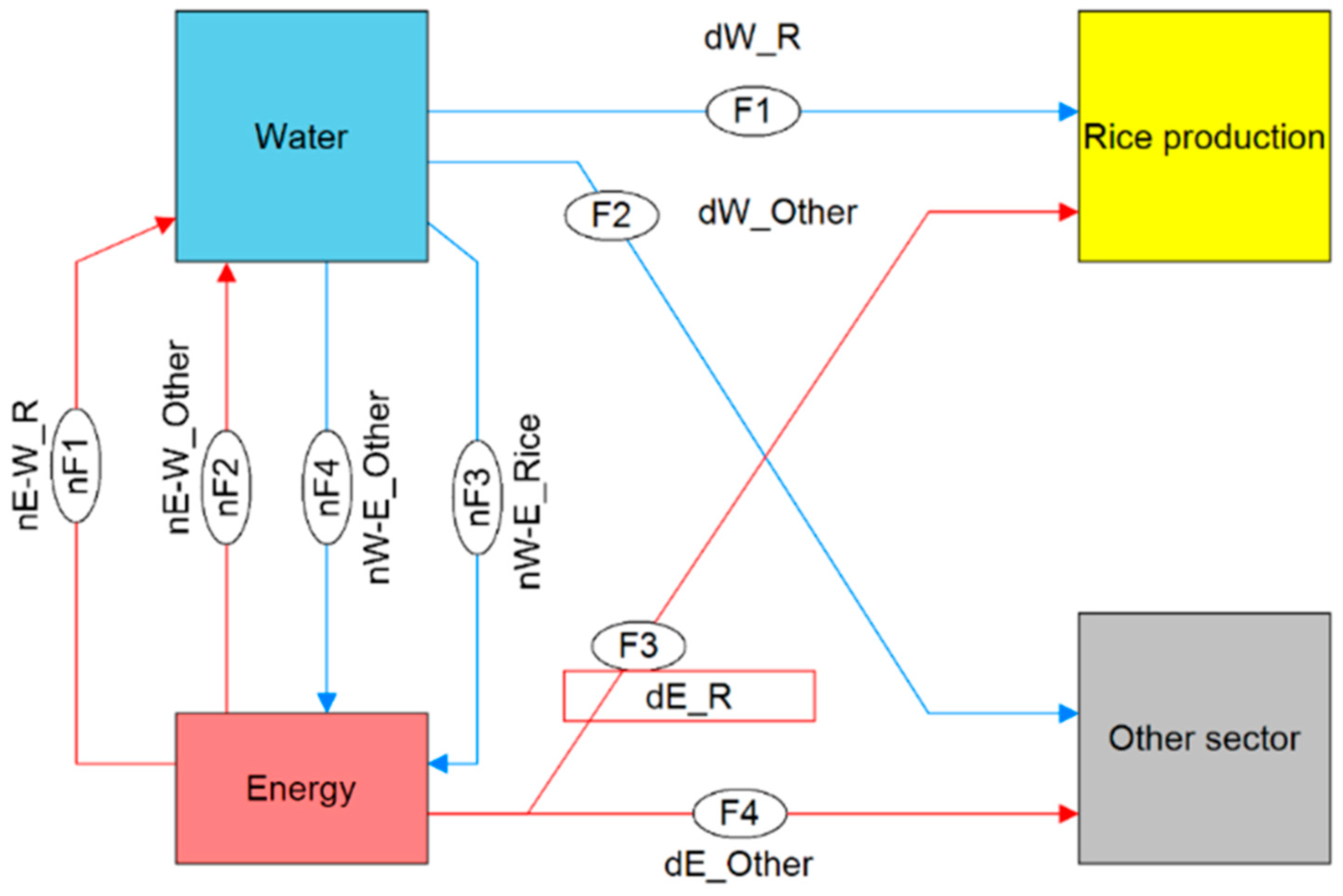

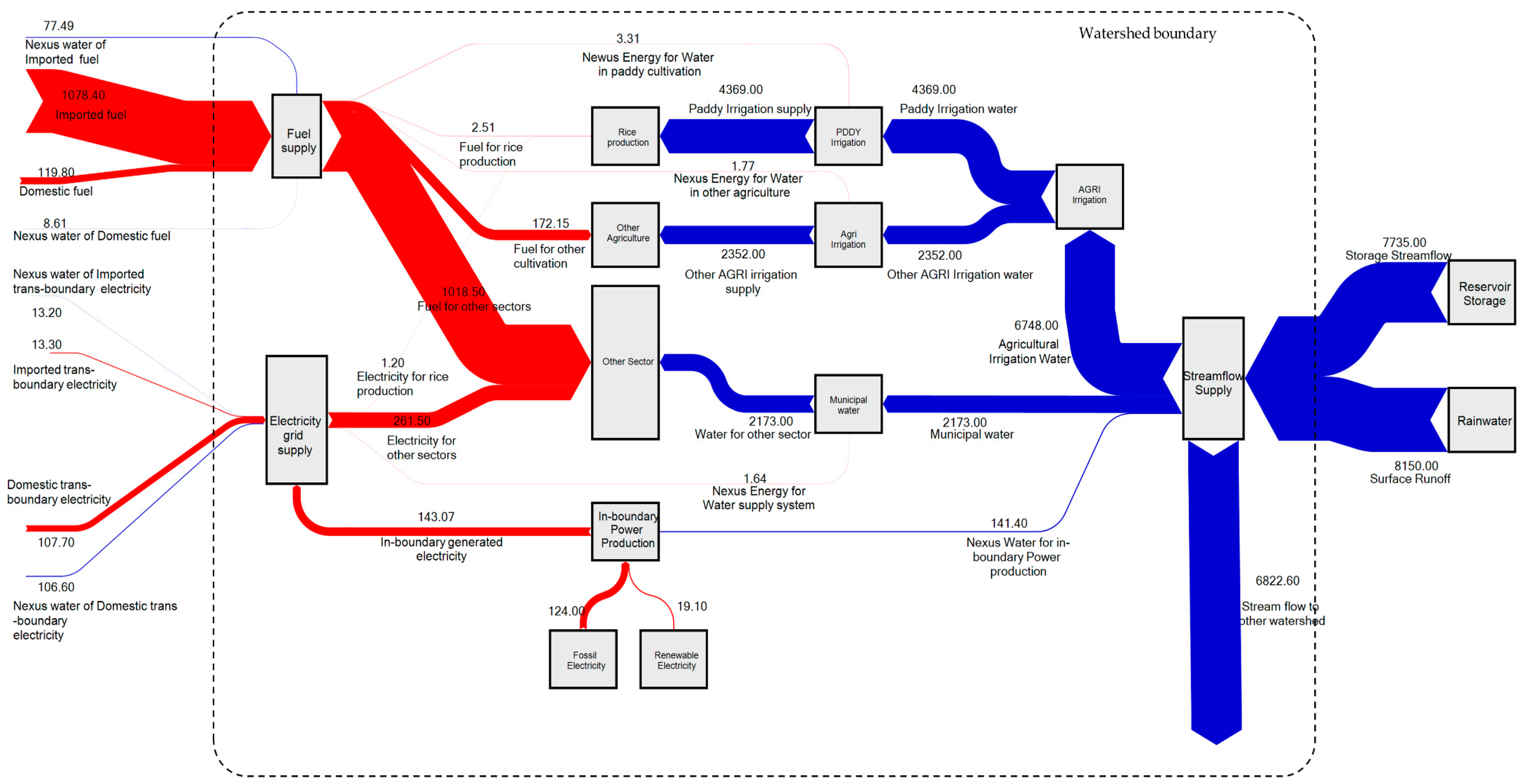
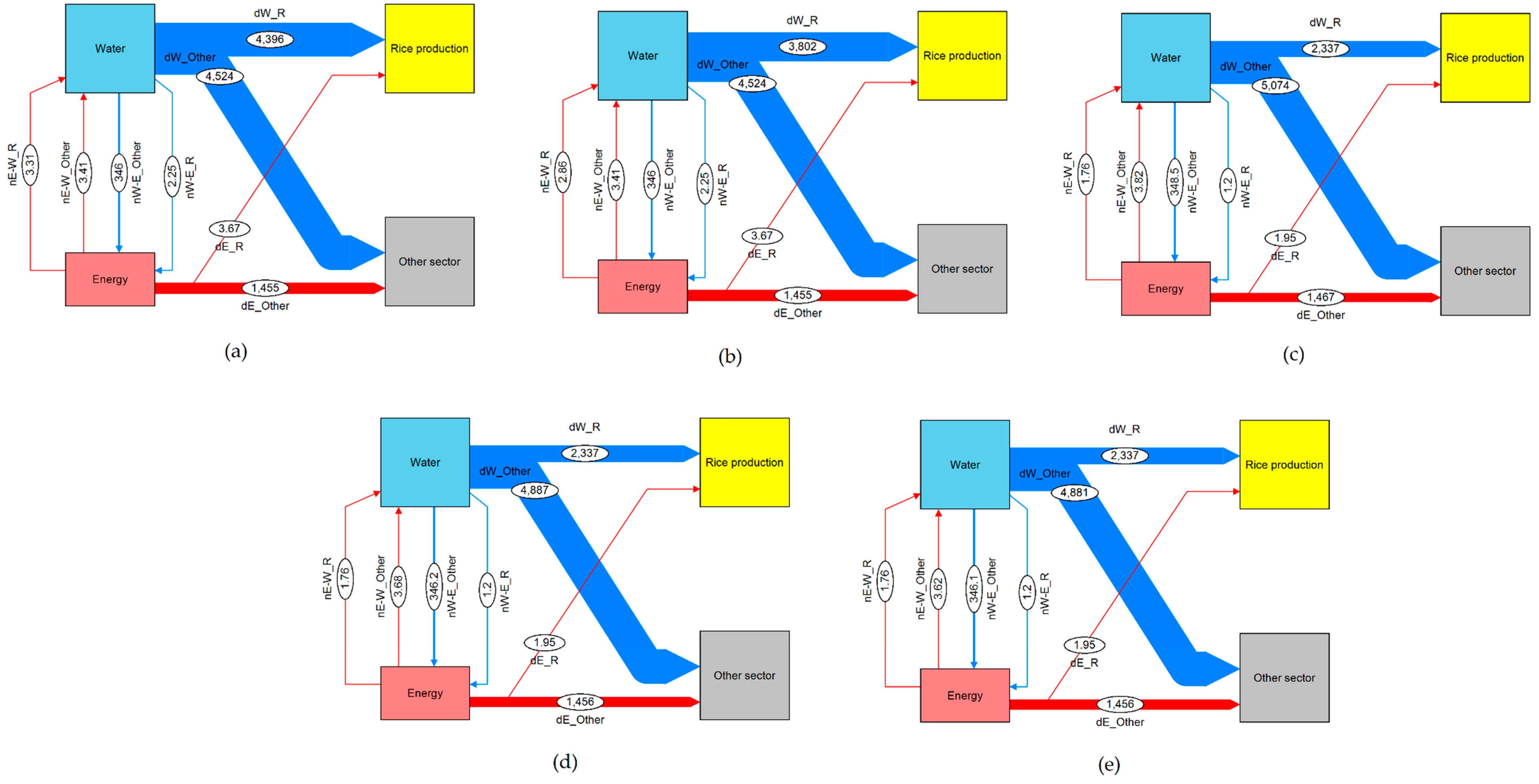
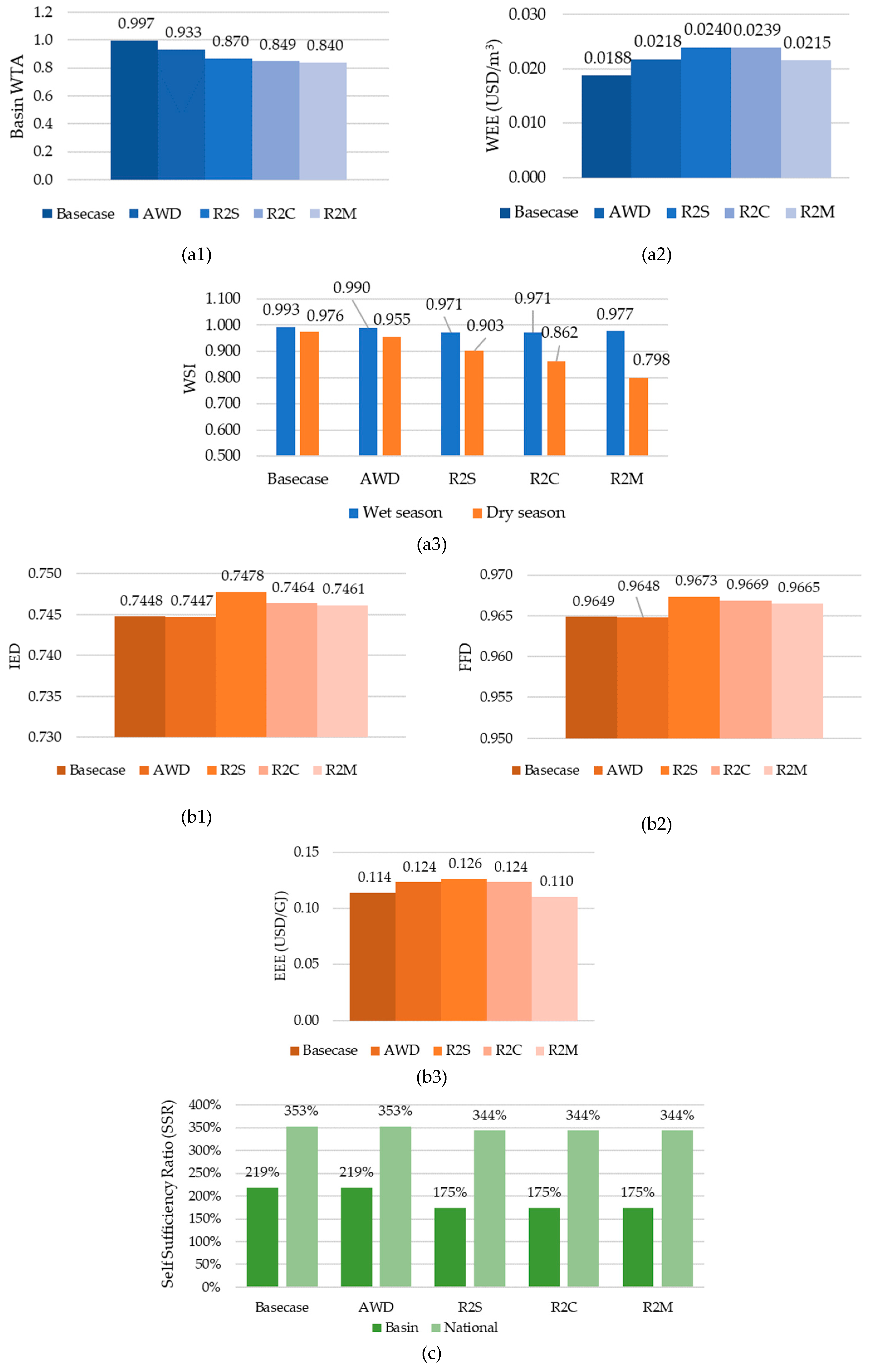
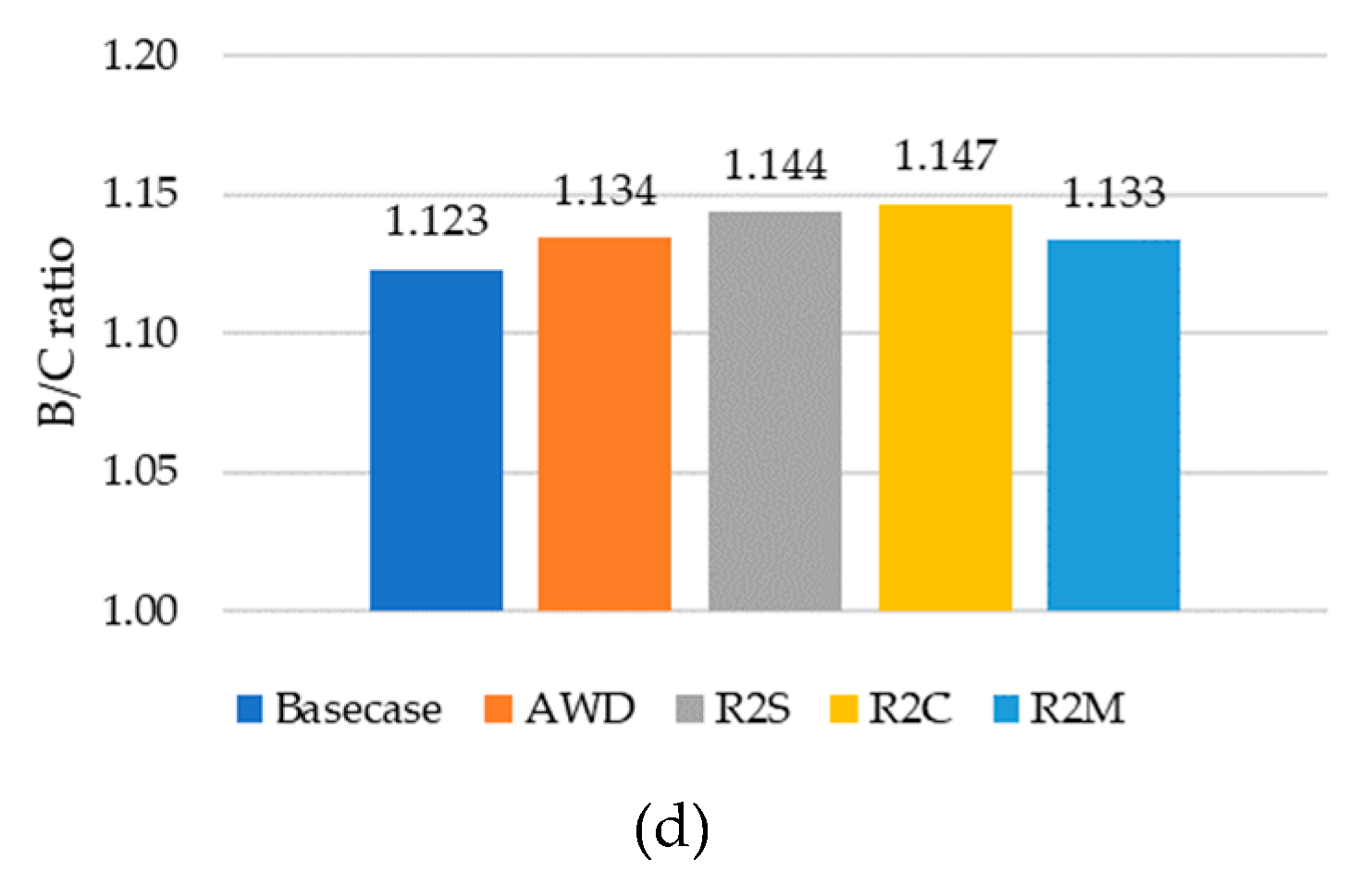
| Year | Rice Cultivation Area (ha) | Average Price (USD tonne-1) | Average First-Rice Yield (kg ha-1) | Annual Paddy Rice (tonne y-1) |
|---|---|---|---|---|
| 2009 | 988,516 | 267.0 | 667 | 3,762,538 |
| 2010 | 1,006,936 | 234.5 | 600 | 3,606,089 |
| 2011 | 1,043,170 | 272.5 | 607 | 3,507,659 |
| 2012 | 1,041,704 | 286.4 | 663 | 3,919,410 |
| 2013 | 755,804 | 247.1 | 664 | 2,886,228 |
| 2014 | 1,000,759 | 218.6 | 650 | 3,827,904 |
| 2015 | 902,930 | 217.0 | 641 | 3,352,127 |
| 2016 | 905,721 | 212.8 | 628 | 3,785,395 |
| 2017 | 931,434 | 222.9 | 648 | 3,568,558 |
| 2018 | 930,208 | 236.2 | 664 | 3,592,927 |
| Average | 950,718 | 241.5 | 643 | 3,561,034 |
| Title | Equation | Description |
|---|---|---|
| Direct Water for Rice supply (dW_R) (million m3) | dW_R = Wdircul + Wdirpro | Wdircul is the direct irrigation water in cultivation (million m3) Wdirpro is the direct water for rice milling process (million m3) |
| Direct Energy for Rice supply (dE_R) (million GJ) | dE_R = Edircul + Edirpro | Edircul is the direct energy consumption in cultivation process (million GJ) except irrigation water pumping Edirpro is the direct energy consumption in rice milling process (million GJ) |
| Nexus Energy for Water for Rice supply (nE-W_R) (million GJ) | nE-W_R = Wdircul x wErice | Wdirrice is the direct irrigation water use in cultivation (million m3) wErice = Energy use factor for rice irrigation water (0.000753 GJ/m3) |
| Nexus Water for Energy for Rice supply (nW-E_R) (million m3) | nW-E_R = wEindircul + wEdirpro | wEindircul is the water use for diesel ((Ediecul) in cultivation process (million m3) wEdirpro is the water use for diesel (wEdiepro) and electricity (wEelepro) in rice milling process (million m3) |
| Direct Water for Other sectors (dW_Other) (million m3) | dW_Other = Wdiragri + Wdirmuni | Wdiragri is the direct irrigation water withdrawal for the cultivation of other crops (million m3) Wdircomm is the direct water utilized in the household, livestock, and industry (million m3) |
| Direct Energy for Other sectors (dE_Other) (million GJ) | dE_Other = Edir_fuelagri + Edir_fuelmuni + Edir_elecagri + Edir_elecmuni | Edir_fuelagri is the fuel consumption in other agriculture processes (million GJ) Edir_fuelcomm is the fuel consumption in the household, livestock, and industry (million GJ) Edir_elecagri is the electricity consumption in other agriculture processes (million GJ) Edir_eleccomm is the electricity consumption in the household, livestock, and industry (million GJ) |
| Nexus Energy for Water in Other sectors (nE-W_Other) (million GJ) | Wdirsect,i is the direct water use of other section i (million m3) wEsect,i = Nexus Energy used for water supply usage of other section i (0.000753 GJ/m3 ) | |
| Nexus Water for Energy in Other sectors (nW-E_Other) (million m3) | nW-E_Other = wEindirfuel,imp + wEindirelec,imp + wEindirelec,trnb + wEdir,PPelec | wEindirfuel,imp is the water use for international diesel imported into the basin. (million GJ) wEindirelec,imp is the water use for international electricity imported into the basin. (million GJ) wEindirelec,trnb is the water use for domestic grid-mixed electricity transboundary imported into the basin. (million GJ) wEdirPPelec is the direct water used for internal powerplant inside basin excluding electricity used in rice milling process (million GJ) |
| Group | Indices | Calculation |
|---|---|---|
| Water security | Water Withdrawal to Availability ratio (WTA) | |
| Water Stress Index (WSI) [13] | ||
| Water Economic Eco-efficiency (WEE) | ||
| Energy security | Fossil Fuel Dependency (FFD) | |
| Imported Energy Dependency (IED) | ||
| Energy Eco-efficiency (EEE) | ||
| Food security | Self-Sufficiency Ratio (SSR) | |
| Economic proficiency | Benefit/Cost ratio |
| Scenario | Description |
|---|---|
| Scenario 1 AWD | Change 50% area of rice production to Alternate Wet and Dry AWD) system cultivation practice). |
| Scenario 2 R2C | Change 160,000 ha of non-suitable, low-suitable and mid-suitable areas of rice to sugarcane cultivation. |
| Scenario 3 R2C | Change 160,000 ha of non-suitable, low-suitable and mid-suitable areas of rice cultivation to cassava. |
| Scenario 4 R2M | Change 160,000 ha of non-suitable, low-suitable and mid-suitable areas of rice cultivation to maize. |
© 2019 by the authors. Licensee MDPI, Basel, Switzerland. This article is an open access article distributed under the terms and conditions of the Creative Commons Attribution (CC BY) license (http://creativecommons.org/licenses/by/4.0/).
Share and Cite
Ngammuangtueng, P.; Jakrawatana, N.; Nilsalab, P.; Gheewala, S.H. Water, Energy and Food Nexus in Rice Production in Thailand. Sustainability 2019, 11, 5852. https://doi.org/10.3390/su11205852
Ngammuangtueng P, Jakrawatana N, Nilsalab P, Gheewala SH. Water, Energy and Food Nexus in Rice Production in Thailand. Sustainability. 2019; 11(20):5852. https://doi.org/10.3390/su11205852
Chicago/Turabian StyleNgammuangtueng, Pitak, Napat Jakrawatana, Pariyapat Nilsalab, and Shabbir H. Gheewala. 2019. "Water, Energy and Food Nexus in Rice Production in Thailand" Sustainability 11, no. 20: 5852. https://doi.org/10.3390/su11205852







